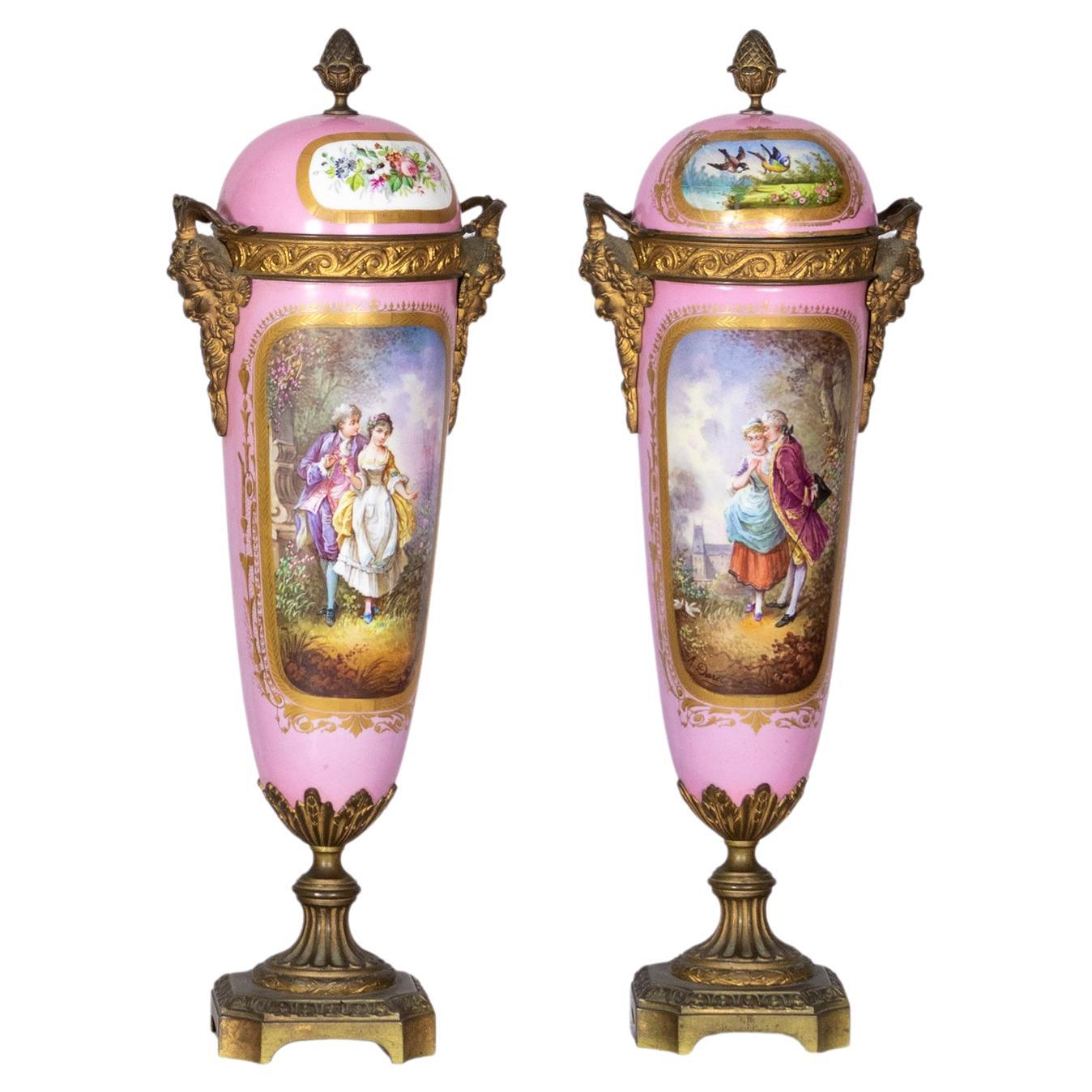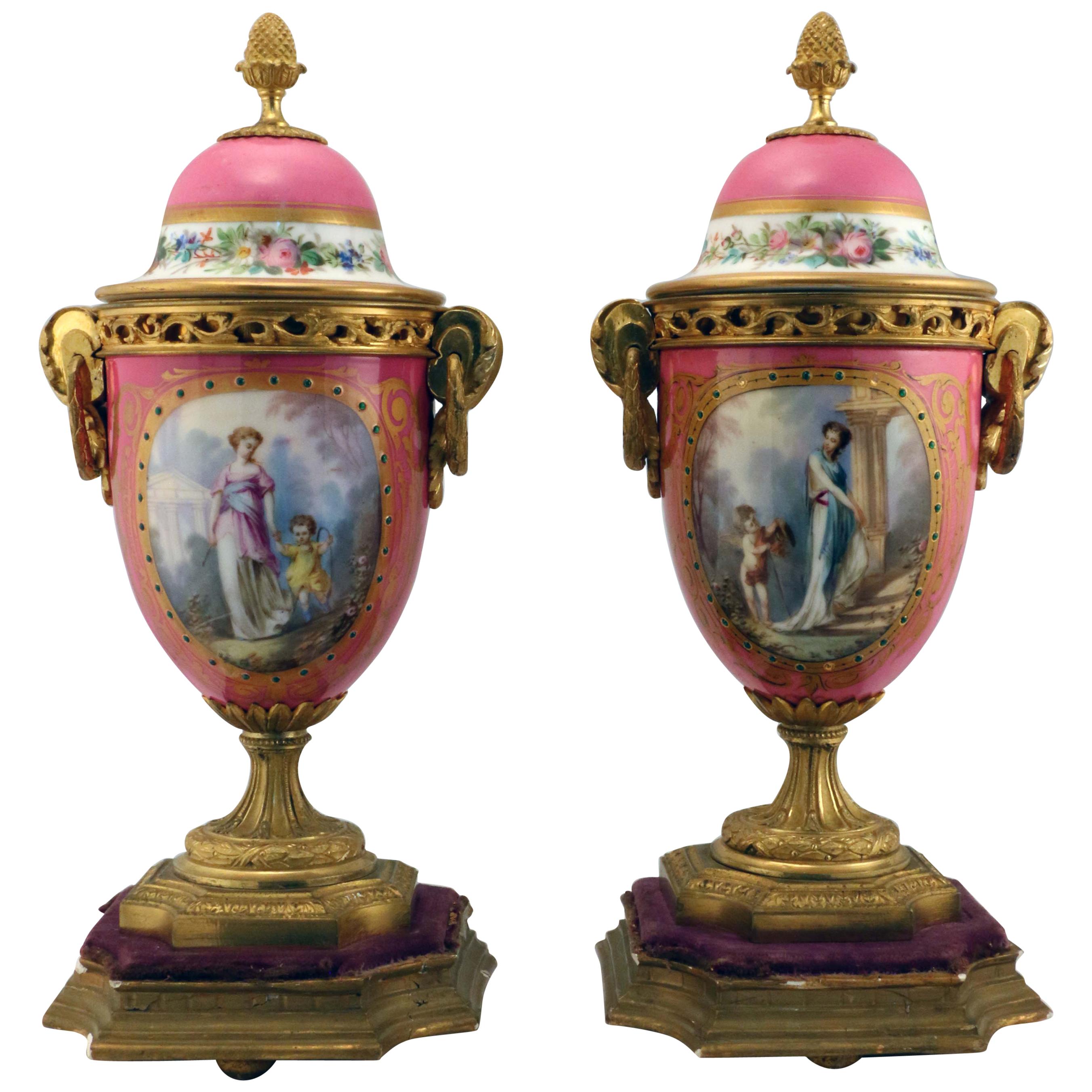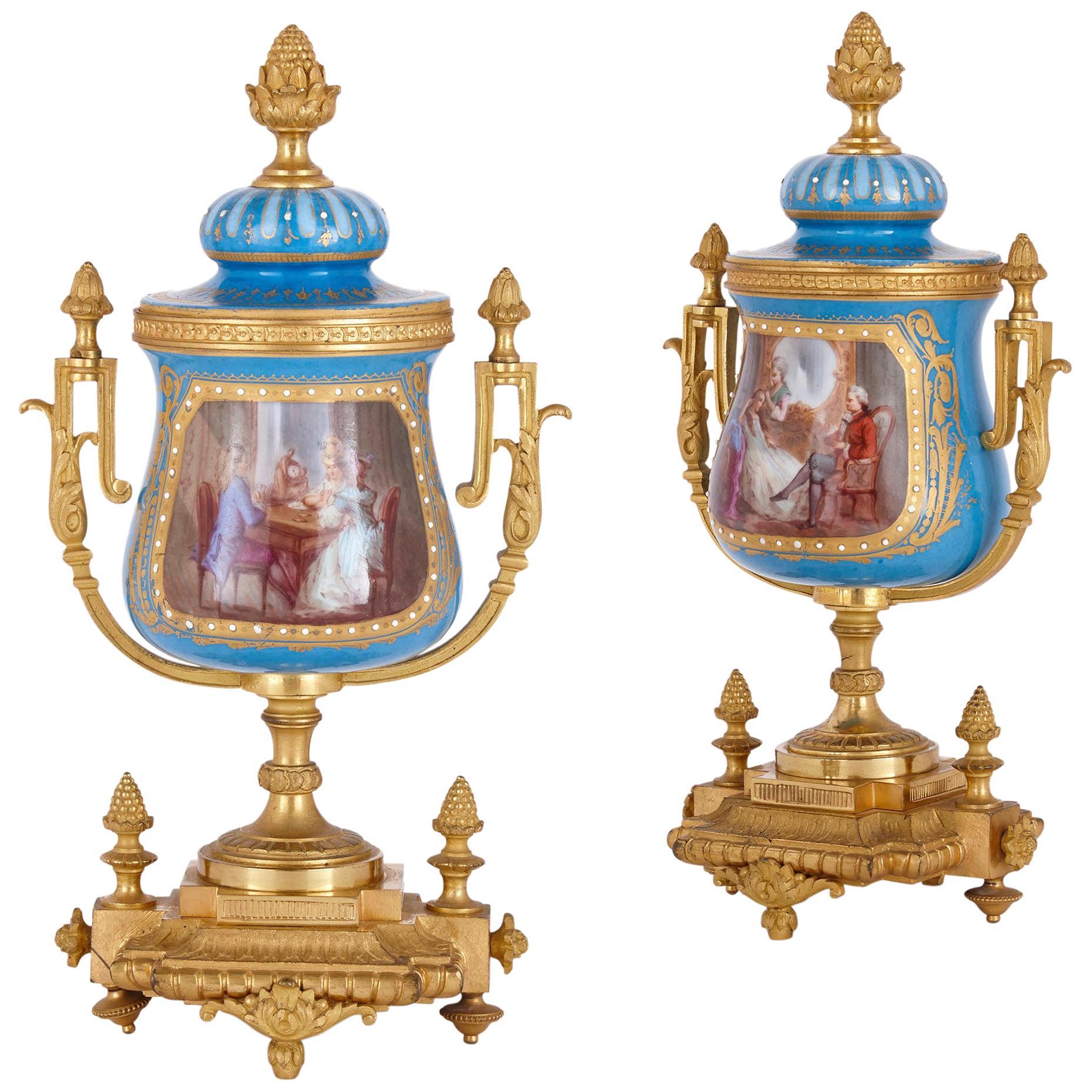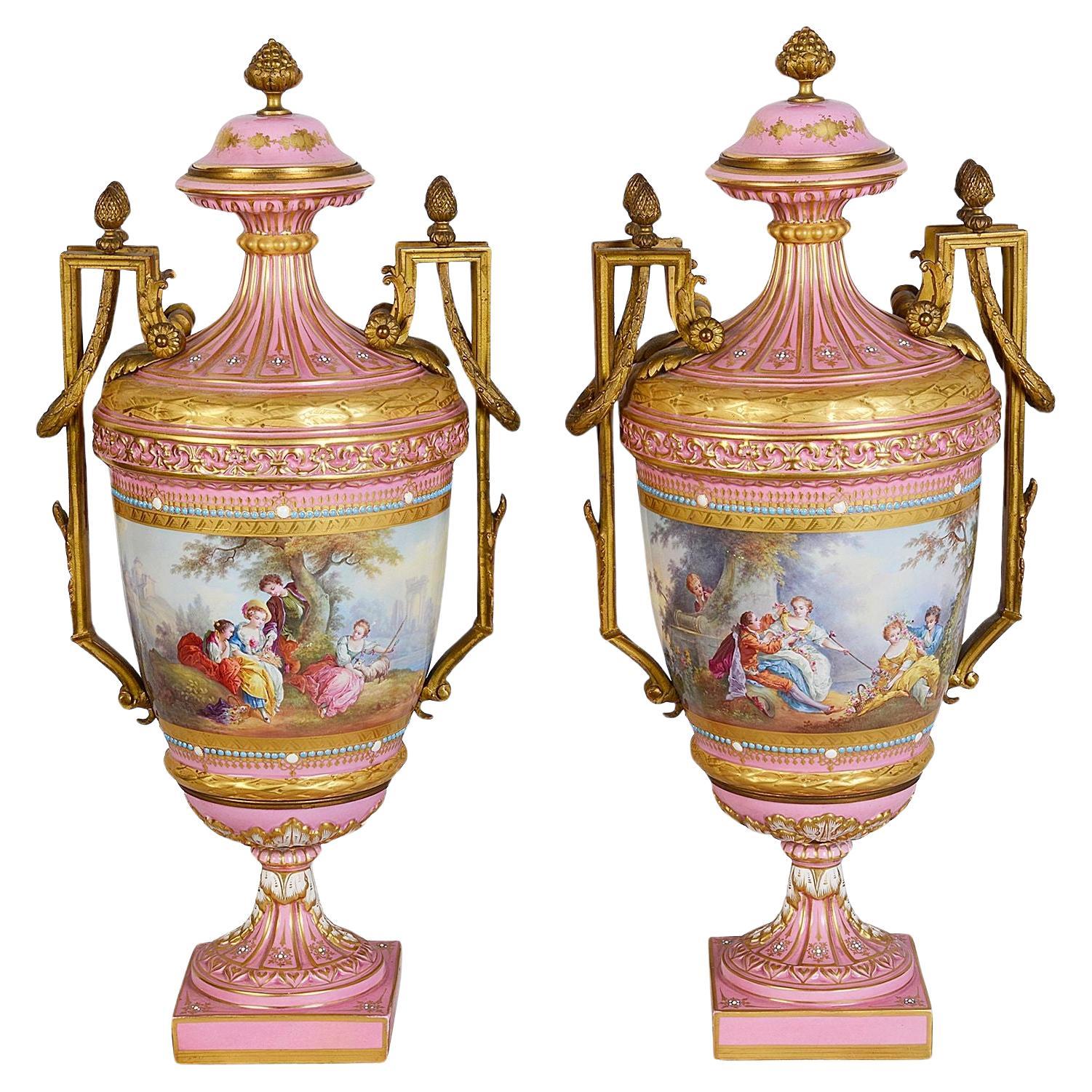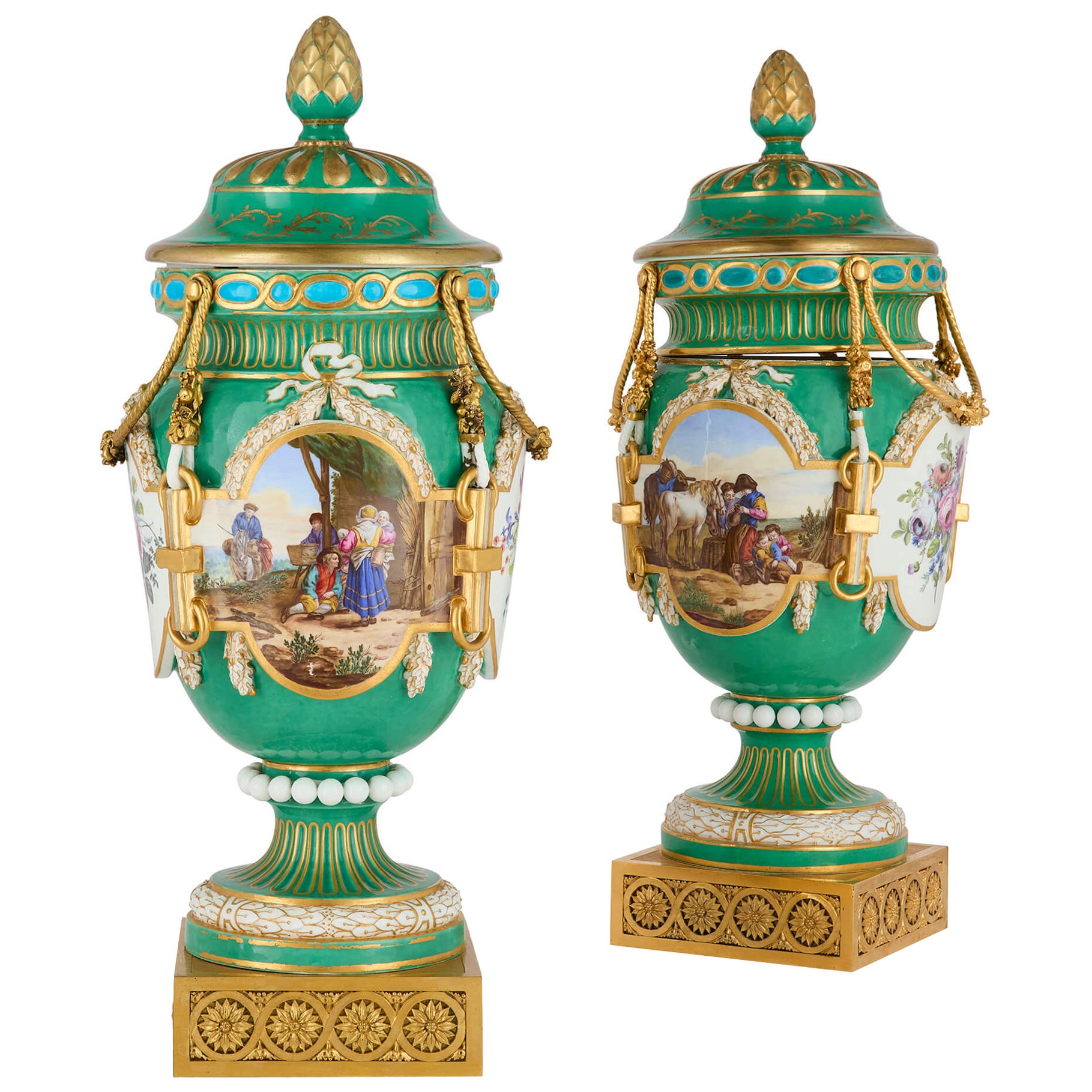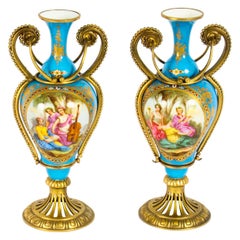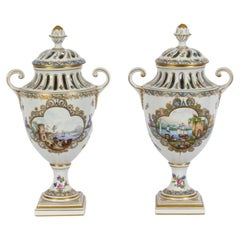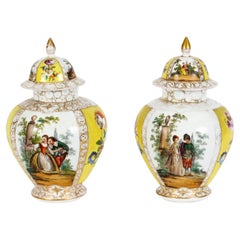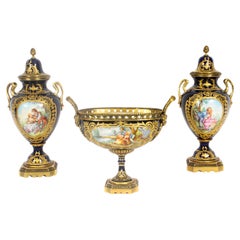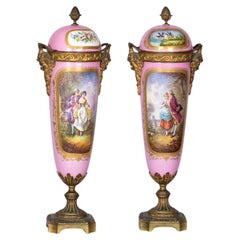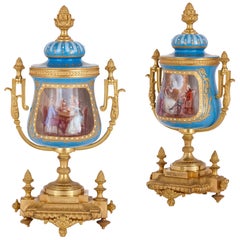Items Similar to Antique Pair French Ormolu Mounted Pink Sevres Lidded Vases, 19th C
Video Loading
Want more images or videos?
Request additional images or videos from the seller
1 of 22
Antique Pair French Ormolu Mounted Pink Sevres Lidded Vases, 19th C
$3,745.38per set
£2,750per set
€3,222.66per set
CA$5,250.08per set
A$5,784.37per set
CHF 2,994.34per set
MX$69,645.31per set
NOK 37,915.59per set
SEK 35,619.30per set
DKK 24,063.31per set
About the Item
This is a beautiful antique pair of French Sevres porcelain and ormolu mounted lidded vases, Circa 1860 in date.
With domed lids and fluted bodies, they are superbly decorated with hand painted classical garden scenes of courting couples, after Boucher, within gilt edged borders on a pink ground.
Of the highest quality, the vases are raised on turned ormolu feet with matching scrolled ormolu handles.
They are delightful objects which will look good in any surrounding.
Condition:
In really excellent condition with no chips, cracks or signs of repair, please see photos for confirmation of condition.
Dimensions in cm:
height 29 x width 17 x depth 13
Dimensions in inches:
height 11 inches x width 7 inches x depth 5 inches
Sevres Porcelain traces its roots in France to early craftsmen who had small manufacturing operations in such places as Lille, Rouen. St. Cloud, and most notably Chantilly. It is from Chantilly that a cadre of workers migrated to the Chateau de Vincennes near Paris to form a larger porcelain manufactory in 1738.
French King Louis XV, perhaps inspired by his rumoured relationship with mistress Madame de Pompadour, took an intense interest in porcelain and moved the operation in 1756 to even larger quarters in the Paris suburb of Sevres. Sevres was also conveniently near the home of Madame de Pompadour and the King's own Palace at Versailles.
From the outset the king's clear aim was to produce Sevres Porcelain that surpassed the established Saxony works of Meissen and Dresden. Though the French lacked an ample supply of kaolin, a required ingredient for hard-paste porcelain (pate dure), their soft-paste porcelain (pate tendre) was fired at a lower temperature and was thus compatible with a wider variety of colours and glazes that in many cases were also richer and more vivid. Unglazed white Sevres Porcelain "biscuit" figurines were also a great success. However, soft-paste Sevres Porcelain was more easily broken. Therefore, early pieces of Sevres Porcelain that remain intact have become rare indeed.
The Sevres Porcelain manufactory always seemed to be in dire financial straits despite the incredibly fine works it produced. In fact, the king's insistence that only the finest items be created may have contributed to the difficulties. Only a limited number of European nobility could afford the extravagant prices demanded for such works. King Louis XV and eventually his heir, the ill-fated Louis XVI, were obliged to invest heavily in the enterprise. Ultimately, the Sevres Porcelain Factory produced items under the name of "Royal" and thus the well-known Sevres mark was born. King Louis XV even mandated laws that severely restricted other porcelain production in France so as to retain a near monopoly for his Sevres Porcelain. The king even willingly became chief salesman for the finest of his products, hosting an annual New Year's Day showing for French nobility in his private quarters at Versailles. He eagerly circulated among potential buyers, pitching the merits of ownership and policing the occasional light-fingered guest.
Sevres Porcelain may have indeed given the makers of Meissen and Dresden a run for their money by the end of the 18th Century but for the French Revolution. By 1800, the Sevres Porcelain Works were practically out of business due to the economic devastation of the new French Republic.
About the time when Napoleon Bonaparte named himself Emperor of France (1804), a new director was named for the Sevres Porcelain Manufactory. Alexandre Brongniart, highly educated in many fields, resurrected Sevres Porcelain. Soft-paste porcelain was eliminated altogether thanks to the earlier discovery of kaolin near Limoges. For four decades until his death, Brongniart presided over monumental progress for Sevres Porcelain, catering not only to Napoleon himself, but at last to include the more financially profitable mid-priced market in the emerging middle class.
Ormolu (from French 'or moulu', signifying ground or pounded gold) is an 18th-century English term for applying finely ground, high-carat gold in a mercury amalgam to an object of bronze.The mercury is driven off in a kiln leaving behind a gold-coloured veneer known as 'gilt bronze'.
The manufacture of true ormolu employs a process known as mercury-gilding or fire-gilding, in which a solution of nitrate of mercury is applied to a piece of copper, brass, or bronze, followed by the application of an amalgam of gold and mercury. The item was then exposed to extreme heat until the mercury burned off and the gold remained, adhered to the metal object.
No true ormolu was produced in France after around 1830 because legislation had outlawed the use of mercury. Therefore, other techniques were used instead but nothing surpasses the original mercury-firing ormolu method for sheer beauty and richness of colour. Electroplating is the most common modern technique. Ormolu techniques are essentially the same as those used on silver, to produce silver-gilt (also known as vermeil).
- Dimensions:Height: 11.42 in (29 cm)Width: 6.7 in (17 cm)Depth: 5.12 in (13 cm)
- Sold As:Set of 2
- Materials and Techniques:
- Place of Origin:
- Period:
- Date of Manufacture:circa 1860
- Condition:
- Seller Location:London, GB
- Reference Number:Seller: A25291stDibs: LU950628084832
About the Seller
5.0
Platinum Seller
Premium sellers with a 4.7+ rating and 24-hour response times
Established in 1983
1stDibs seller since 2012
1,405 sales on 1stDibs
Typical response time: <1 hour
Associations
LAPADA - The Association of Arts & Antiques Dealers
- ShippingRetrieving quote...Shipping from: London, United Kingdom
- Return Policy
Authenticity Guarantee
In the unlikely event there’s an issue with an item’s authenticity, contact us within 1 year for a full refund. DetailsMoney-Back Guarantee
If your item is not as described, is damaged in transit, or does not arrive, contact us within 7 days for a full refund. Details24-Hour Cancellation
You have a 24-hour grace period in which to reconsider your purchase, with no questions asked.Vetted Professional Sellers
Our world-class sellers must adhere to strict standards for service and quality, maintaining the integrity of our listings.Price-Match Guarantee
If you find that a seller listed the same item for a lower price elsewhere, we’ll match it.Trusted Global Delivery
Our best-in-class carrier network provides specialized shipping options worldwide, including custom delivery.More From This Seller
View AllAntique Pair of French Ormolu Mounted Bleu Celeste Sèvres Vases, 19th Century
Located in London, GB
This is a beautiful antique pair of French Louis Revival Sèvres "Bleu Celeste" porcelain and ormolu mounted twin handled vases, circa 1880 in date.
They are superbly decorated in ...
Category
Antique 1880s French Vases
Materials
Ormolu
Antique Pair Dresden Porcelain Pot Pourri Lidded Vases 1920s 20th C
Located in London, GB
This is a beautiful antique pair of fine quality Dresden porcelain pot pourri urns and covers, circa 1920 in date.
Each painted with harbour scenes on a patterned ground and bearing underglaze blue AR marks.
They are beautiful objects which will look fabulous in all surroundings.
Condition:
In really excellent condition with no chips, cracks or signs of repair, and only very minor signs of wear comensurate with age and use, please see photos for confirmation of condition.
Dimensions in cm:
Height 41 x Width 23 x Depth 17
Dimensions in inches:
Height 1 foot, 4 inches x Width 9 inches x Depth 7 inches
Dresden porcelain - A King's Obsession
In the early 1700s, King Augustus II, prince elector of Saxony, held goldsmith Johann Bottger prisoner and commissioned him to create gold. Bottger instead discovered the method of creating porcelain, a favored and valuable item in the king's eyes.
The king announced to Europe in 1710 that he would open a porcelain manufactory in Dresden. He instead opened one at nearby Albrechtsburg castle. Espionage was rampant, and the king guarded his porcelain secret, even though it meant imprisoning workers within the castle walls.
By 1720, the secret was leaked and porcelain producers popped up in Vienna and Venice. Dresden porcelain adopted Saxon crossed swords in under-glaze blue as its distinguishing mark.
In 1736, the porcelain manufactory produced the "Swan Service...
Category
Vintage 1920s Porcelain
Materials
Porcelain
Antique Pair Dresden Lidded Porcelain Vases & Covers Early 20th Century
Located in London, GB
This is a beautiful pair of Dresden lidded vases and covers, circa 1900 in date.
Superbly painted with panels of figural scenes of courting couples and flowers on a yellow and gilt ground, with underglaze blue Dresden marks to the bases.
They are beautiful objects which will look fabulous in most surroundings.
Condition:
In excellent condition with no chips, cracks or signs of repair, and only very minor signs of wear comensurate with age and use, please see photos for confirmation of condition.
Dimensions in cm:
Height 32 x Width 20 x Depth 20
Dimensions in inches:
Height 1 foot, 1 inch x Width 8 inches x Depth 8 inches
Dresden porcelain - A King's Obsession
In the early 1700s, King Augustus II, prince elector of Saxony, held goldsmith Johann Bottger prisoner and commissioned him to create gold. Bottger instead discovered the method of creating porcelain, a favored and valuable item in the king's eyes.
The king announced to Europe in 1710 that he would open a porcelain manufactory in Dresden. He instead opened one at nearby Albrechtsburg castle. Espionage was rampant, and the king guarded his porcelain secret, even though it meant imprisoning workers within the castle walls.
By 1720, the secret was leaked and porcelain producers popped up in Vienna and Venice. Dresden porcelain adopted Saxon crossed swords in under-glaze blue as its distinguishing mark.
In 1736, the porcelain manufactory produced the "Swan Service...
Category
Antique Early 1900s German Porcelain
Materials
Porcelain
Antique Paris Porcelain & Ormolu Mounted 3 Piece Garniture Early 20th Century
Located in London, GB
A beautiful and monumental Paris porcelain ormolu mounted three piece garniture set with hand-painted scenes and delicate gilt decoration, Circa...
Category
Antique Early 1900s French Porcelain
Materials
Ormolu
Antique Pair French Bleu Celeste Sevres Urns 19th C
Located in London, GB
This is a beautiful antique pair of French Sevres style porcelain and ormolu mounted twin handled urns, in the Louis XV manner, Circa 1870 in date.
The bleu celeste...
Category
Antique 1870s French Urns
Materials
Ormolu
Antique Pair French Grand Tour Gilt Bronze Classical Urns 19th Century
Located in London, GB
This is a remarkable pair of antique French Grand Tour ormolu and Carrara marble urns, circa 1860 in date.
These stunning urns have been superbly cast in the same form as the ancie...
Category
Antique 19th Century French Grand Tour Urns
Materials
Carrara Marble, Bronze, Ormolu
You May Also Like
Pair Of Ormolu Mounted Pink Sevres Vases, Floral Scenes, 19th Century
By Manufacture Nationale de Sèvres
Located in Lisbon, PT
A pair of 19th-century French Sevres lidded urnes, finely mounted in ormolu and hand-painted with floral compositions and romantic scenes.
The soft pink porcelain body is adorned wi...
Category
Antique 19th Century French Rococo Vases
Materials
Bronze
$8,205 Sale Price
25% Off
Pair of Louis XV Style Gilt Bronze Mounted Paris Pink Porcelain Covered Urns
Located in Montreal, QC
This pair are charmingly painted in oval reserves with mother and child within a gilt jeweled border, and verso with wild flowers. Each domed cover is painted correspondingly with a ...
Category
Antique Mid-19th Century French Louis XV Urns
Materials
Bronze
20th Century Pair of Ormolu Mounted Pink Sevres Style Vases with Lids
Located in Southall, GB
A fine pair of Sevres styleporcelain two handled vases and covers with ormolu mounts. 19th century. Each with spiral lobed decoration picked out with flowers on a pink ground. The mo...
Category
20th Century French Vases
Materials
Porcelain
$4,903 Sale Price / set
20% Off
Pair of French Gilt Bronze Mounted Porcelain Vases
By Manufacture Nationale de Sèvres
Located in London, GB
Pair of French gilt bronze mounted porcelain vases
French, late 19th century
Measures: Height 28cm, width 14cm, depth 10cm
This wond...
Category
Antique Late 19th Century French Louis XV Vases
Materials
Ormolu, Bronze
Pair Pink Sevres style vases, 19th Century
By Cristalleries De Sevres
Located in Brighton, Sussex
A fine quality pair of late 19th Century French Sevres style, Pink porcelain lidded vases. Each with gilded ormolu handles, hand painted romantic scenes around, and raised on pedesta...
Category
Antique Late 19th Century French Vases
Materials
Porcelain
Pair of Antique Sèvres Porcelain Ormolu-Mounted Vases
By Manufacture Nationale de Sèvres
Located in London, GB
Pair of antique Sèvres porcelain ormolu-mounted vases
French, 18th Century
Height 50cm, diameter 21cm
Dating from the 18th century, t...
Category
Antique 18th Century French Louis XVI Porcelain
Materials
Ormolu
More Ways To Browse
White Porcelain Figurine
Sevres Biscuit
Antique White Porcelain Figurines
Biscuit Figurines
Sevres Figurine
Sevres Porcelain Figurines
Sevres Porcelain 1860
Antique Sevres Lidded
Antique Dresden Plates
Antique White Porcelain Figurines
Kpm Plate
Meissen Cup Saucer
Meissen Lid
Salt And Pepper Porcelain
Salvador Dali Glasses
Spode Brown
Vintage Fine China
Wedgwood Rare
